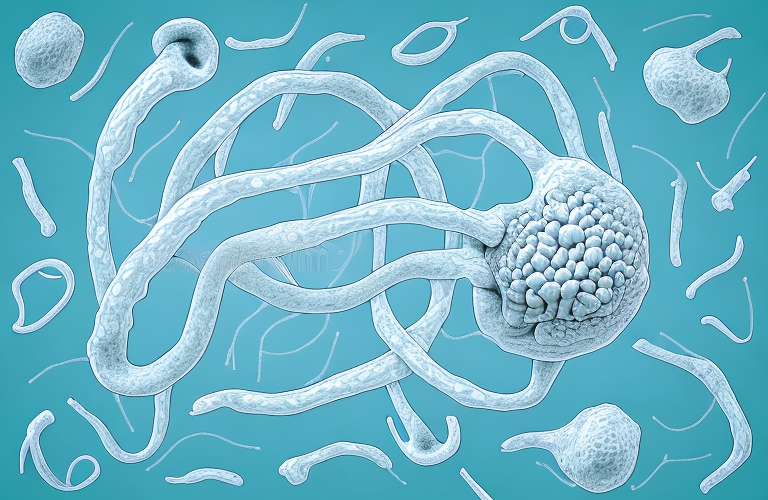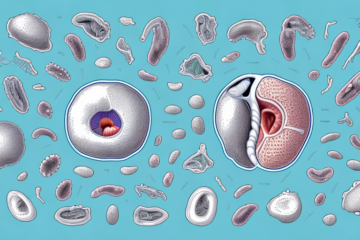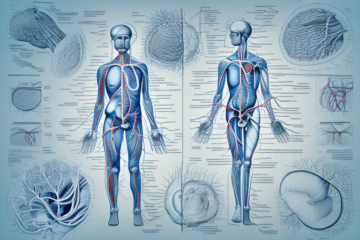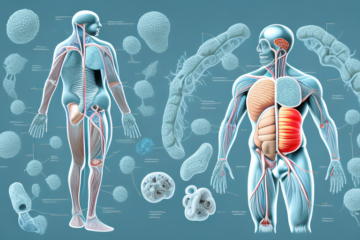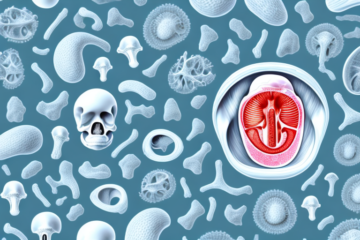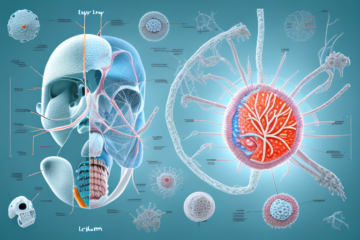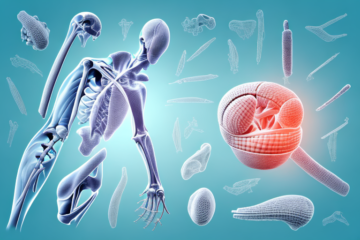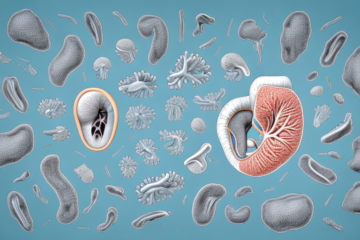The female reproductive system is complex, and one of its crucial components is the fallopian tubes. These tubes are responsible for transporting the egg from the ovaries to the uterus, where it may be fertilized by sperm and implant for pregnancy. In this article, we will explore the function, anatomy, conditions, and treatments of the fallopian tubes, along with recent research advancements and prevention strategies.
Understanding the Female Reproductive System
Before diving into the specifics of the fallopian tubes, let us first understand the female reproductive system. It comprises various organs, hormones, and physiological processes working together to produce an egg, facilitate its fusion with sperm, and nurture a developing fetus. The primary reproductive organs are the ovaries, where eggs are produced, and the uterus or womb, which supports the fetus during pregnancy. The fallopian tubes bridge these structures by providing a pathway for the egg to travel to the uterus.
In addition to the ovaries and uterus, the female reproductive system also includes the cervix, which is the lower part of the uterus that connects to the vagina. The cervix produces mucus that helps sperm travel through the reproductive tract and into the uterus. The vagina, also known as the birth canal, is the muscular tube that connects the cervix to the outside of the body. It plays a crucial role in sexual intercourse and childbirth.
The Role of Fallopian Tubes in Conception
The fallopian tubes play a crucial role in conception. They not only transport the egg but also provide a site for fertilization to take place. After ovulation, the egg rests in the fallopian tube’s fimbriae, which are finger-like projections that sweep over the ovaries and catch the egg. From there, the egg travels through the tube towards the uterus. Meanwhile, the sperm swim through the cervix and into the uterus, where they may meet and unite with the egg in the fallopian tube’s ampulla. The fertilized egg, now called a zygote, continues its journey towards the uterus, where it may implant in the uterine lining and develop into a fetus.
However, there are certain conditions that can affect the function of the fallopian tubes and hinder conception. For example, blockages or scarring in the tubes can prevent the egg and sperm from meeting, leading to infertility. Infections such as pelvic inflammatory disease (PID) can also cause damage to the tubes, making it difficult for them to function properly.
In some cases, medical intervention may be necessary to help couples conceive when the fallopian tubes are not functioning properly. Treatments such as in vitro fertilization (IVF) bypass the need for the egg and sperm to meet in the fallopian tubes, instead fertilizing the egg in a laboratory and then transferring it to the uterus. Other options may include surgery to repair or remove damaged portions of the tubes.
Anatomy of the Fallopian Tubes: A Detailed Look
The fallopian tubes are two thin tubes, each around 10-12 centimeters in length and 1-4 millimeters in diameter. They are located in the pelvis, on either side of the uterus. The tubes have four sections: the infundibulum, the ampulla, the isthmus, and the intramural segment. The infundibulum is the broad funnel-shaped end of the tube that is closest to the ovary, while the intramural segment is the narrow part that enters the uterine wall. The ampulla is the middle segment, where fertilization usually occurs, while the isthmus is the narrow part closest to the uterus. The fallopian tubes have three layers: the serosa, the muscularis, and the mucosa. The serosa is the outermost layer that covers the tube’s surface, while the muscularis is the middle layer made of smooth muscle fibers that contract to propel the egg towards the uterus. The mucosa is the inner layer that lines the lumen or hollow center of the tube.
The fallopian tubes play a crucial role in the reproductive system of females. They are responsible for transporting the egg from the ovary to the uterus, where it can be fertilized by sperm. However, in some cases, the fallopian tubes may become blocked or damaged, which can lead to infertility. Common causes of fallopian tube damage include pelvic inflammatory disease, endometriosis, and previous surgeries in the pelvic area.
In some cases, medical intervention may be necessary to repair or remove damaged fallopian tubes. This can involve surgery to remove scar tissue or blockages, or in severe cases, the removal of the entire tube. In cases where both fallopian tubes are damaged or removed, in vitro fertilization (IVF) may be an option for couples who are struggling with infertility.
How Fallopian Tubes Transport Eggs to the Uterus
The fallopian tubes employ various mechanisms to transport the egg towards the uterus. Firstly, the fimbriae create a current that gently sweeps the egg towards the infundibulum. Secondly, the muscularis contracts rhythmically and propels the egg towards the uterus. Thirdly, the lining of the tubes secretes mucus that acts as a lubricant and nourishment for the egg and sperm. The mucus is thinner near the ovary and thicker near the uterus, creating a gradient that guides the egg towards the uterus and prevents unwanted particles from entering the tubes.
It is important to note that the fallopian tubes play a crucial role in fertilization. Once the egg is released from the ovary, it can only survive for 12-24 hours. If it is not fertilized during this time, it will disintegrate and be absorbed by the body. Therefore, the timely transport of the egg through the fallopian tubes is essential for successful fertilization.
In some cases, the fallopian tubes may become blocked or damaged, which can lead to infertility. This can be caused by various factors such as infections, endometriosis, or previous surgeries. In such cases, assisted reproductive technologies such as in vitro fertilization (IVF) may be used to bypass the fallopian tubes and achieve pregnancy.
Causes and Symptoms of Fallopian Tube Blockage
Unfortunately, the fallopian tubes may become blocked or damaged, leading to infertility or ectopic pregnancy, which is a potentially life-threatening condition. Some common causes of fallopian tube blockage are infections, such as chlamydia or gonorrhea, autoimmune diseases, endometriosis, pelvic inflammatory disease, and previous surgery or trauma. The symptoms of blocked tubes may include pelvic pain, abnormal vaginal bleeding, and infertility, but some women may not have any symptoms at all.
It is important to note that certain lifestyle factors can also contribute to the development of fallopian tube blockage. Smoking, for example, has been linked to an increased risk of tubal infertility. Additionally, exposure to certain chemicals or toxins in the environment may also play a role in the development of this condition.
If you suspect that you may have a blocked fallopian tube, it is important to seek medical attention as soon as possible. Your doctor may recommend a variety of diagnostic tests, such as a hysterosalpingogram or laparoscopy, to determine the extent of the blockage and develop an appropriate treatment plan.
Diagnosing and Treating Blocked Fallopian Tubes
If you suspect that you have blocked fallopian tubes, you should visit a gynecologist or reproductive endocrinologist for evaluation and diagnosis. They may perform various tests such as hysterosalpingography, laparoscopy, or hysteroscopy to visualize the tubes and diagnose any blockages or abnormalities. Depending on the cause and severity of the blockage, your doctor may recommend treatment options such as antibiotics, surgery, in-vitro fertilization (IVF), or assisted reproductive technologies (ARTs) such as intracytoplasmic sperm injection (ICSI) or gamete intrafallopian transfer (GIFT).
It is important to note that there are several risk factors that can increase the likelihood of developing blocked fallopian tubes. These include a history of sexually transmitted infections (STIs), pelvic inflammatory disease (PID), endometriosis, and previous abdominal or pelvic surgery. Therefore, it is important to practice safe sex and seek prompt treatment for any infections or conditions that may affect your reproductive health.
In addition to medical treatments, there are also lifestyle changes that can help improve your chances of conceiving with blocked fallopian tubes. These include maintaining a healthy weight, reducing stress, and avoiding smoking and excessive alcohol consumption. Your doctor may also recommend alternative therapies such as acupuncture or herbal supplements to support your fertility.
Surgical Options for Fallopian Tube Repair or Removal
If the fallopian tubes are damaged or blocked, surgery may be an option to repair or remove them. The type of surgery depends on the extent and location of the problem, as well as the woman’s age, fertility status, and overall health. Some examples of surgical procedures for fallopian tubes are salpingostomy, salpingectomy, fimbrioplasty, and tubal ligation reversal. These surgeries have varying success rates and risks, and you should discuss the benefits and drawbacks with your doctor before making a decision.
One of the most common causes of fallopian tube damage is pelvic inflammatory disease (PID), which is often caused by sexually transmitted infections. In some cases, antibiotics may be used to treat the infection and prevent further damage to the tubes. However, if the damage is severe, surgery may be necessary.
In addition to surgical options, there are also non-surgical options for women who are unable or unwilling to undergo surgery. For example, in vitro fertilization (IVF) can bypass the fallopian tubes altogether by fertilizing the egg outside of the body and then transferring the embryo directly into the uterus. This may be a good option for women who have severely damaged or blocked tubes, or who have had unsuccessful surgery in the past.
Alternatives to Traditional Fallopian Tube Surgery
If you are not a candidate for traditional fallopian tube surgery, or if you prefer less invasive options, there are alternative treatments available. Some of these treatments are natural therapies such as herbal remedies, acupuncture, or yoga, while others are medical interventions such as fallopian tube cannulation, which involves flushing the tubes with a special solution, or in-vitro maturation (IVM), which allows eggs to mature outside the body before being fertilized. These alternative treatments may have limited research support and may not be covered by insurance, but they may be worth exploring if you are seeking non-surgical options.
One alternative treatment for fallopian tube issues is called tubal reanastomosis. This procedure involves reconnecting the fallopian tubes after they have been previously cut or blocked. It is a surgical procedure, but it is less invasive than traditional fallopian tube surgery and has a higher success rate. However, it is important to note that not all women are candidates for this procedure.
Another alternative treatment is called in-vitro fertilization (IVF). This procedure involves fertilizing eggs outside of the body and then transferring the resulting embryos into the uterus. IVF bypasses the fallopian tubes altogether, making it a viable option for women with blocked or damaged tubes. However, IVF can be expensive and may not be covered by insurance.
The Importance of Healthy Fallopian Tubes for Fertility
Healthy fallopian tubes are essential for fertility, and any damage or blockage may significantly impact your chances of getting pregnant naturally or with assisted reproductive technologies. Therefore, it is vital to maintain good gynecological health by practicing safe sex, getting regular pap smears, and seeking prompt treatment for any infections or conditions that may affect your fallopian tubes. Additionally, if you have a history of infertility or miscarriages, or if you are planning to conceive, you should consult a fertility specialist to rule out any fallopian tube issues.
There are several factors that can cause damage or blockage to the fallopian tubes, including pelvic inflammatory disease, endometriosis, and previous surgeries. In some cases, surgery may be necessary to repair or remove damaged tubes. However, if both tubes are severely damaged or blocked, in vitro fertilization (IVF) may be the best option for conception. IVF involves retrieving eggs from the ovaries and fertilizing them with sperm in a laboratory, then transferring the resulting embryos to the uterus. A fertility specialist can help determine the best course of action based on your individual circumstances.
Common Conditions Affecting the Fallopian Tubes
Several conditions may affect the fallopian tubes, ranging from minor to severe. Some common examples are salpingitis, which is inflammation of the tubes, hydrosalpinx, which is the accumulation of fluid in the tubes, and tubal factor infertility, which is the reduced or absence of tube function. Other conditions that may affect the tubes indirectly are endometriosis, pelvic adhesions, and fibroids. These conditions may lead to scarring, blockage, or dysfunction of the tubes and may require specialized treatments.
It is important to note that certain lifestyle factors may also contribute to the development of fallopian tube conditions. Smoking, for example, has been linked to an increased risk of tubal infertility and ectopic pregnancy. Additionally, sexually transmitted infections such as chlamydia and gonorrhea can cause damage to the tubes if left untreated. Therefore, practicing safe sex and seeking prompt medical attention for any symptoms of infection is crucial in maintaining the health of the fallopian tubes.
Preventing Infections and Other Issues with the Fallopian Tubes
The best way to prevent infections or other issues with the fallopian tubes is to practice good hygiene, use condoms during sex, and avoid multiple sexual partners. Similarly, if you have a history of sexually transmitted infections (STIs), you should get tested and treated promptly. Other ways to prevent issues with the tubes are to quit smoking, maintain a healthy weight, and manage conditions such as diabetes or hypertension that may affect fertility. Additionally, you should be aware of your family and personal medical history and discuss any concerns with your doctor.
It is also important to note that certain medical procedures, such as surgeries or treatments for cancer, may affect the health of the fallopian tubes. If you are planning to undergo any medical procedures, it is important to discuss the potential impact on your fertility with your doctor. Additionally, if you experience any symptoms such as pelvic pain, abnormal bleeding, or difficulty conceiving, you should seek medical attention promptly to prevent any potential issues with the fallopian tubes from worsening.
Pregnancy After Tubal Ligation: What You Need to Know
Tubal ligation, also known as “getting your tubes tied,” is a permanent form of birth control that involves blocking or cutting the fallopian tubes to prevent pregnancy. However, in some cases, women may regret their decision to undergo tubal ligation and seek to reverse it. While tubal ligation reversal may be possible, it is not always successful, and the chances of getting pregnant after reversal depend on various factors such as age, the type of sterilization method used, and the extent of tubal damage. Therefore, it is crucial to consider all options before undergoing tubal ligation and to consult a specialist for advice.
It is important to note that there are alternative forms of birth control that are not permanent and may be more suitable for some women. These include hormonal methods such as the pill, patch, or injection, as well as non-hormonal methods such as condoms, diaphragms, and copper IUDs. It is recommended to discuss these options with a healthcare provider to determine the best choice for individual needs and preferences.
In addition, it is important to consider the emotional and psychological impact of undergoing tubal ligation. Some women may experience feelings of regret, grief, or loss after the procedure, especially if they later decide they want to have children. It is important to seek support from loved ones or a mental health professional if these feelings arise, and to remember that there are options available for starting or expanding a family, such as adoption or surrogacy.
Research and Advances in Understanding the Function of Fallopian Tubes
Finally, let us look at some recent research and advances in the understanding of fallopian tube function. Scientists have discovered that the tubes play a more active role in reproduction than previously thought. For example, the tubes may facilitate the selection and maturation of the egg and sperm, prevent genetic abnormalities, and communicate with the uterus to signal the ideal time for implantation. Researchers are also exploring new treatments for tubal factor infertility, such as fallopian tube tissue engineering or transplantation. These advances offer hope for women who have struggled with fallopian tube issues and may lead to more successful fertility treatments in the future.
One recent study found that the fallopian tubes may also play a role in the immune system’s response to pregnancy. The study showed that the tubes contain immune cells that help to protect the developing embryo from infections and other threats. This discovery could have important implications for understanding and treating conditions such as recurrent miscarriage or ectopic pregnancy, which are often associated with problems in the fallopian tubes. Further research is needed to fully understand the role of the immune system in fallopian tube function, but this is an exciting area of study for reproductive medicine.
Conclusion
In conclusion, the fallopian tubes are a critical component of the female reproductive system, and their function, anatomy, conditions, and treatments are vast and complex. Whether you are trying to conceive, seeking fertility treatment, or simply curious about your body, it is essential to understand the importance of healthy fallopian tubes and to seek timely medical advice if you suspect any issues with them. By taking care of your gynecological health and staying informed about the latest research, you can better navigate the journey towards a healthy and fulfilling reproductive life.
It is important to note that certain lifestyle factors can impact the health of your fallopian tubes. Smoking, for example, has been linked to an increased risk of tubal infertility and ectopic pregnancy. Additionally, sexually transmitted infections such as chlamydia and gonorrhea can cause inflammation and scarring of the tubes, leading to blockages and fertility issues.
While there are various treatments available for fallopian tube conditions, including surgery and assisted reproductive technologies, prevention is always the best approach. Practicing safe sex, getting regular gynecological check-ups, and maintaining a healthy lifestyle can all help to protect the health of your fallopian tubes and improve your chances of a successful pregnancy.

